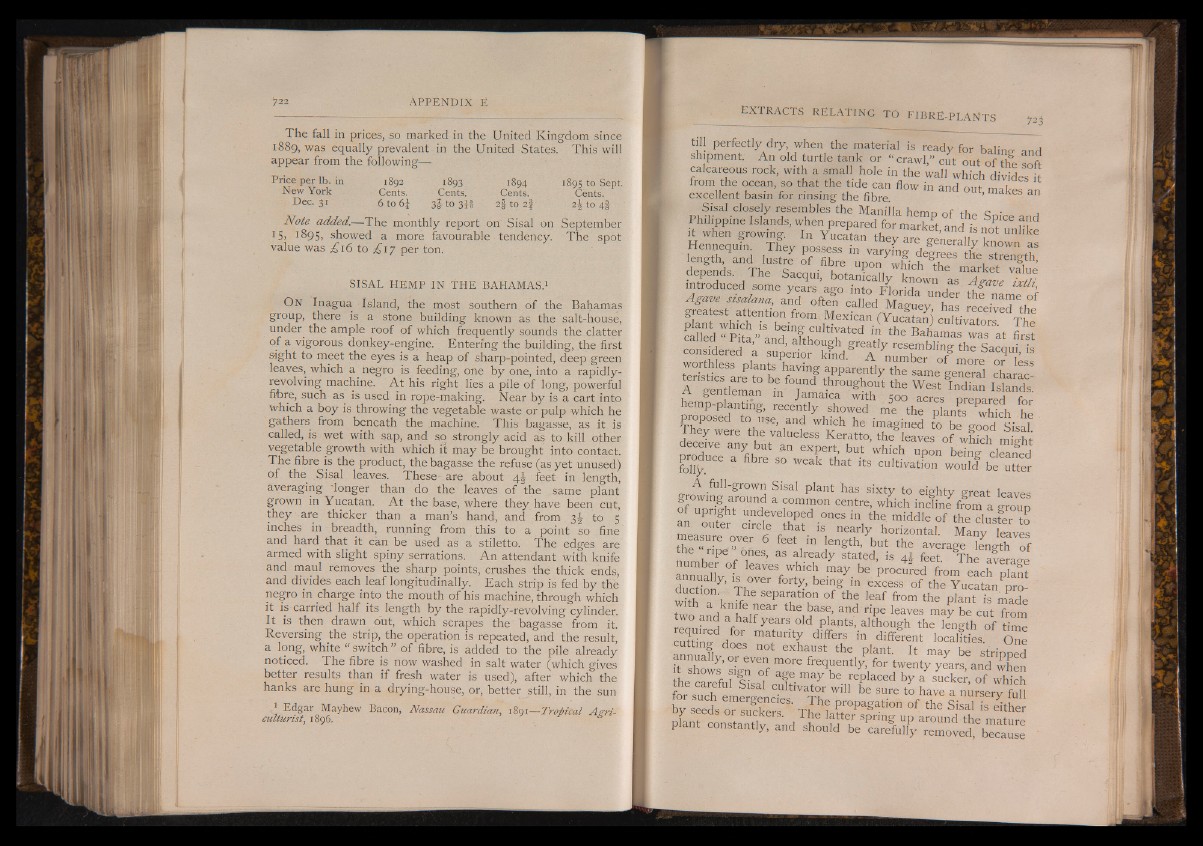
The fall in prices, so marked in the United Kingdom since
1889, was equally prevalent in the United States. This will
appear from the following—
Price per lb. in 1892 1893 1894 1895 to Sept.
New York Cents. Cents. Cents. Cents.
Dec. 31 6 to 6§ 3& t ° 3H 2 | t o 2 f 2 j t o 4 f
Note added.— The monthly report on Sisal on September
15) ^95, showed a more favourable tendency. The spot
value was £16 to ¿ 1 7 per ton.
SISAL HEMP IN THE BAHAMAS.1
O n Inagua Island, the most southern of the Bahamas
group, there is a stone building known as the salt-house,
under the ample roof of which frequently sounds the clatter
of a vigorous donkey-engine. Entering the building, the first
sight to meet the eyes is a heap of sharp-pointed, deep green
leaves, which a negro is feeding, one by one, into a rapidly-
revolving machine. A t his right lies a pile of long, powerful
fibre, such as is used in rope-making. Near by is a cart into
which a boy is throwing the vegetable waste or pulp which he
gathers^ from beneath the machine. This bagasse, as it is
called, is wet with sap, and so strongly acid as to kill other
vegetable growth with which it may be brought into contact.
The fibre is the product, the bagasse the refuse (as yet unused)
of the Sisal leaves. These-are about 4^ feet in length,
averaging longer than do the leaves of the same plant
grown in Yucatan. A t the base, where they have been cut,
they are thicker than a man’s hand, and from 3 J to 5
inches in breadth, running from this to a point so fine
and hard that it can be used as a stiletto. The edges are
armed with slight spiny serrations. An attendant with knife
and maul removes the sharp points, crushes the thick ends,
and divides each leaf longitudinally. Each strip is fed by the
negro in charge into the mouth of his machine, through which
it is carried half its length by the rapidly-revolving cylinder.
It is then drawn out, which scrapes the bagasse from it.
Reversing the strip, the operation is repeated, and the result,
a long, white “ switch ” of fibre, is added to the pile already
noticed. The fibre is now washed in salt water (which gives
better results than if fresh water is used), after which the
hanks are hung in a drying-house, or, better still, in the sun
1 Edgar Mayhew Bacon, Nassau Guardian, 1891— Tropical A m -
cultunst, 1896.
till perfectly dry, when the material is ready for baling IHt
shipment. An old turtle tank or “ crawl,” cut out of the soft
calcareous rock, with a small hole in the wall which divides t
from the ocean, so that the tide can flow in and out, makes an
excellent basin for rinsing the fibre an
Sisal closely resembles the Manilla hemp of the Spice and
Philippine Islands, when prepared for market, and is not unlike
it when growing. In Yucatan they are r a e r d v t l
Hennequin. They possess in varying- decree« rR I T
length, and lustre of fibre upon which f f c j l , freng. >
depends The Sacqui, b o ta n S ly a s “ 1 “ ^
introduced some years ago into Florida under th fn am fo f
Agave sisalana, and often ealRri A/r„ , name ot
worthless plants having apparently th^s^ 1 8 1 ° l leSS
A^gentleman P ^ ^ ^
hemp-planting, recently^howTd ml^the0 pknts^whkh he
proposed to use, and which he imagined to be go^d Sisal
They were the valueless Keratto, the leaves of whfih m£h t
deceive any but an expert, but which upon being cleaned
folfyUCe a fibre 30 W£ak that its H M be utter
A full-grown Sisal plant has sixty to eighty great leaves
o fT n n4 arrOUnf a ™ ° n centre> ^ i c h incfine from a group
an mite ie ?ped .ones 1 the middle of the clusfer to
m outer circle that is nearly horizontal. Many leaves
° ver 6 feet m length, but the average length of
the ripe ones, as already stated is aI feet H B H S
number of leaves which may be p^ u re !i L n each’ S a S
m m ‘^ 7 “ fort? ' excess separation of the leaf fromo ft hthee pVlauncta tiasn m pardoet
j n ie llea r base, and ripe leaves may be cut from
9 B afhalf y ears old plants, although the length of time
ccuuttttiinng? dnd°oeers Eno?t “e1x?ha ust the inp ladnitf.f ereInt t m‘»ay« bef lst rinOnende
R shows’ t n S j freqaent1^ .for twenty years, and when
the carefu Sisal cnlH■ by a SUcker’ of wh^h
nt «S ^ n d ^ t e S l y ^ S S ■